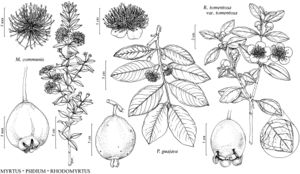Psidium
Sp. Pl. 1: 470. 1753.
| Taxon | Illustrator ⠉ | |
|---|---|---|
 | Myrtus communis Psidium guajava Rhodomyrtus tomentosa var. tomentosa |
Shrubs or trees, glabrous or pubescent, hairs simple. Leaves sometimes drought deciduous, opposite; blade venation usually brochidodromous. Inflorescences 1-flowered or 3-flowered, axillary, solitary flowers or dichasia; bracteoles caducous. Flowers usually 5-merous, sessile or pedicellate; hypanthium obconic; calyx lobes distinct or connate beyond summit of ovary to form calyx-tube, sometimes forming calyptra (in closed flower bud, calyptra completely closed or open only as a terminal pore, tearing regularly into 5 lobes or irregularly); petals whitish; stamens [100–] 280–720; ovary [2-locular or] 3–6-locular; placenta bilamelate, often protruding as a peltate structure; ovules 12–180 per locule, biseriate or multiseriate. Fruits berries, green, yellow, or red, pyriform, globose, or subglobose. Seeds few–100+; seed-coat dull, bony, densely woody, ca. 9–30 cells thick at narrowest point, covered with thin layer of pulpy tissue when wet, or glaze or crusty tissue when dry; embryo curved; cotyledons usually reflexed, linear to elliptic, shorter than hypocotyl.
Distribution
Introduced; Florida, Mexico, West Indies, Central America, South America (except Chile)
Discussion
Species ca. 70 (2 in the flora).
Selected References
None.
Lower Taxa
Key
| 1 | Leaf blades glabrous, obovate, oblanceolate, or elliptic, lateral veins 8–13 pairs (weak to obscure); floral buds each usually with a terminal pore, apex rounded. | Psidium cattleyanum |
| 1 | Leaf blades appressed-pubescent abaxially, elliptic, elliptic-oblanceolate, elliptic-obovate, lanceolate, or oblong, lateral veins 9–22 pairs (prominent); floral buds each without terminal pore, apex usually conic. | Psidium guajava |